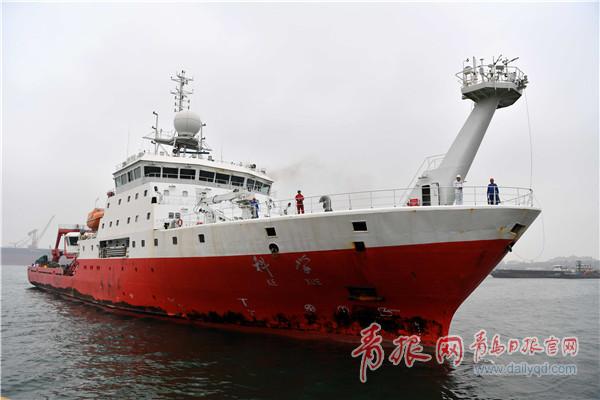


Chinese oceanic scientists on Tuesday revealed their plan to upgrade the country's real-time scientific observation network in the tropical West Pacific by exploring the feasibility of deploying subsurface buoys of more than 3,000 meters under the sea, during the 2018 global deployment of China's Kexue (Science) research vessel.
The research vessel, operated by the Qingdao-based Institute of Oceanology of the Chinese Academy of Sciences, set sail from its home port in Qingdao, East China's Shandong Province on Monday, embarking on its 8,500-nautical-mile journey to the tropical West Pacific, according to a statement by the institute sent to the Global Times on Tuesday.
Wang Jianing, a research fellow with the institute, and also the chief scientist for the project, said in the statement that "a real-time observation network has been established in the waters since the end of 2017.
Chinese scientists have successfully collected deep sea monitoring data from 3,000 meters under the sea for over 320 days," he said.
"The latest journey for the vessel eyes to maintain the existing undersurface buoys while upgrading their observing capabilities by increasing the numbers of buoys and exploring the possibility of deploying buoys at greater depths," Wang said.
Chen Linlin, another research fellow with the project, who cooperated in the research vessel's 2017 trip, told the Global Times on Tuesday that "the monitoring data includes the temperature, salinity and current information in the Western Pacific Warm Pool where the buoys are installed."
"Real-time observation of these maritime indicators, helps the Chinese scientists better understand the water dynamics in the Warm Pool, providing key data to study and predict the extreme weather such as typhoons and drought in the East Asian region, as well as the global climate change phenomena such as El Nino," Chen explained.
Researchers aim to deploy buoys that are capable of transmitting such data in a real-time manner deeper than 3,000 meters during the new journey for the vessel, Wang Min, a publicist with the institute told the Global Times.
He stressed that it has yet to determine how much deeper its attempt will be.
"The deeper the buoys can go, the more accurate indicators for the study will be. However, going deeper also means longer transmission distance and more interfering factors," Wang said.
According to Wang, Chinese scientists first achieved real-time scientific observation of 1,000 meters under the sea at the end of 2016 and had enhanced such capabilities to 3,000 meters under the sea by the end of 2017.
The research vessel is expected to return to Qingdao by February 2019.

 Award-winning photos show poverty reduction achievements in NE China's Jilin province
Award-winning photos show poverty reduction achievements in NE China's Jilin province People dance to greet advent of New Year in Ameiqituo Town, Guizhou
People dance to greet advent of New Year in Ameiqituo Town, Guizhou Fire brigade in Shanghai holds group wedding
Fire brigade in Shanghai holds group wedding Tourists enjoy ice sculptures in Datan Town, north China
Tourists enjoy ice sculptures in Datan Town, north China Sunset scenery of Dayan Pagoda in Xi'an
Sunset scenery of Dayan Pagoda in Xi'an Tourists have fun at scenic spot in Nanlong Town, NW China
Tourists have fun at scenic spot in Nanlong Town, NW China Harbin attracts tourists by making best use of ice in winter
Harbin attracts tourists by making best use of ice in winter In pics: FIS Alpine Ski Women's World Cup Slalom
In pics: FIS Alpine Ski Women's World Cup Slalom Black-necked cranes rest at reservoir in Lhunzhub County, Lhasa
Black-necked cranes rest at reservoir in Lhunzhub County, Lhasa China's FAST telescope will be available to foreign scientists in April
China's FAST telescope will be available to foreign scientists in April